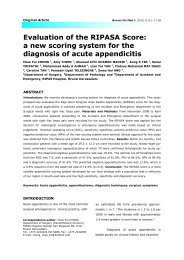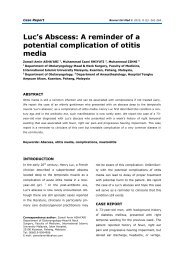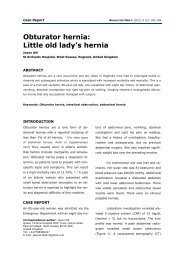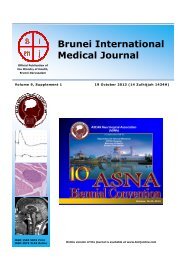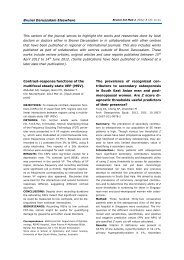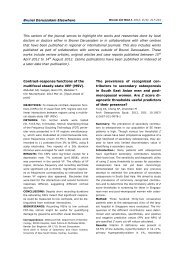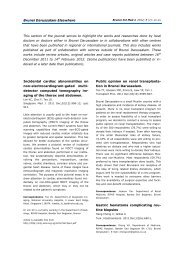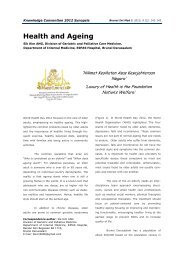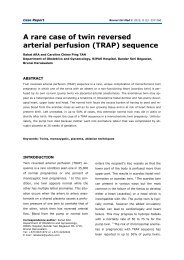BIMJ February 2012 1 - Brunei International Medical Journal
BIMJ February 2012 1 - Brunei International Medical Journal
BIMJ February 2012 1 - Brunei International Medical Journal
You also want an ePaper? Increase the reach of your titles
YUMPU automatically turns print PDFs into web optimized ePapers that Google loves.
<strong>Brunei</strong> Darussalam Elsewhere <strong>Brunei</strong> Int Med J. <strong>2012</strong>; 8 (2): 111-114This section of the journal serves to highlight the works and researches done by localdoctors or doctors either in <strong>Brunei</strong> Darussalam or in collaborations with other centresthat have been published in regional or international journals. This also includes workspublished as part of collaboration with centres outside of <strong>Brunei</strong> Darussalam. Theseworks include review articles, original articles and case reports published between 16 thDecember 2011 to 14 th April <strong>2012</strong>. (Some publications have been published or indexedat a later date than publication).Incidental cardiac abnormalities onnon-electrocardiogram-gated multidetectorcomputed tomography imagingof the thorax and abdomen.Lim KC, Chai F, Teo LS.Singapore Med J. 2011 Dec;52(12):906-12; quiz913.Little attention is usually paid to the heart on nonelectrocardiogram(ECG)-gated multi-detector computedtomography (MDCT) imaging of the thoraxand abdomen. The current MDCT systems have fastscanning capabilities that render non-ECG-gatedimages with reduced cardiac motion artefacts dueto greater temporal and spatial resolution. This hasallowed for better evaluation of the cardiac structures.We present a pictorial review of incidentalcardiac abnormalities found on MDCT imaging ofthe thorax and abdomen performed in our institution.We systematically describe abnormalities involvingthe pericardium, myocardium, cardiacvalves, cardiac chambers, coronary artery and congenitalheart disease. Some of these images haveechocardiograph and magnetic resonance imagingcorrelation. The purpose of this pictorial essay is todraw attention to cardiac abnormalities found incidentallyon non-ECG-gated MDCT imaging of thethorax and abdomen, which may or may not berelated to the patient's symptoms.Correspondence: Teo LN. Department of Diagnostic Imaging,National University Hospital, 5 Lower Kent RidgeRoad, Singapore 119074. lynette_ls_teo@nuhs.edu.sg.Dr Lim KC is currently working in the Department of Radiology,RIPAS Hospital, Bandar Seri Begawan, <strong>Brunei</strong>.Article is available free fromhttp://http://smj.sma.org.sg/5212/5212pe1.pdfPublic opinion on renal transplantationin <strong>Brunei</strong> Darussalam.Teo TT, Hossain MM, Zinna S, Liew YP, Tan J.Transplant Proc. 2011 Dec;43(10):3599-603.<strong>Brunei</strong> Darussalam is a small Muslim country with ahigh prevalence and incidence of kidney disease. Atpresent, there is no local transplant program forpatients on the renal replacement therapy program.In order to assess feasibility of a local transplantprogram, we decided to conduct a survey to assesspublic opinion on renal transplantation. The majorityof the 300 respondents (78.7%) were willing todonate their kidneys if needed. Even after learningof the small theoretical risks of kidney failure,72.33% of all respondents were still willing to proceedwith transplantation. Respondents who hadrelatives on dialysis and who had a higher educationlevel were more willing to donate their kidneys.There was no significant difference between Muslimsand non-Muslims. Most respondents (59.7%)preferred to have transplantation done locally. Thisstudy shows that most <strong>Brunei</strong>ans are receptive ofthe idea of living related kidney donations, whichaugurs well for the sustainability of a new program.More work is needed to overcome other barrierslike the availability of surgical expertise and facilitiesand cost-benefit considerations.Correspondence: Jackson Tan. Department of RenalMedicine, RIPAS Hospital, Bandar Seri Begawan, <strong>Brunei</strong>Darussalam.Gastric hematoma complicating routinebiopsiesChong VH, Jalihal ATurk J Gastroenterol. 2011 Dec;22(6):650-1.Correspondence: Chong VH. Department of Medicine,RIPAS Hospital, Bandar Seri Begawan BA 1710, <strong>Brunei</strong>Darussalam. E mail: chongvuih@yahoo.co.uk
<strong>Brunei</strong> Int Med J. <strong>2012</strong>; 8 (2): 112A case of breakage of LMA Supremeon its first useSimon BP.Indian J Anaesth. 2011; 55;635-6.Correspondence: Simon BP, Department of Anaesthesiology,RIPAS Hospital, Bandar Seri Begawan BA 1710, <strong>Brunei</strong>Darussalam. E mail: binusimon@yahoo.comEpidemiology of burns in a major referralhospital in <strong>Brunei</strong> Darussalam.Pande KC, Ishak HLSingapore Med J. <strong>2012</strong> Feb;53(2):124-7.Introduction: Burn injuries are a public health concernacross the world, particularly in SoutheastAsia, where epidemiological data is lacking. Thisretrospective study was conducted to assess theepidemiology of patients with burns treated at amajor referral hospital in <strong>Brunei</strong> Darussalam, withparticular reference to demographics and aetiology.Methods: All patients were referred to and treatedat the Burns Unit, where data was recorded by theon-duty nurse on a pre-designed form at the firstattendance. A total of 211 patients (111 male, 100female), comprising 10 inpatients and 201 outpatients,were treated during the study period. Results:The average age of the patients was 19.6 ±20.9 (median 10, range < 1-90) years. 67 (32%)patients were under two years of age. Scalding dueto hot liquids was the most common cause(78.2%), followed by flame and contact burns. Themajority of burns were sustained indoors either athome or at work (87.2%). The total body surfacearea (TBSA%) for the whole sample was 3.7% ±7.9% (median 2%; range 1%-90%). Patients withflame burns (n = 19) were older and had largerTBSA% (p < 0.05). Inpatients had significantlyhigher TBSA% compared to outpatients (28.2% ±26% versus 2.5% ± 2.1%; p < 0.005). Conclusion:Scald burns sustained indoors are the most commonacross all age groups. Although the TBSA issmall, a large number of children are affected.There is a need for burns prevention education programmein <strong>Brunei</strong> Darussalam.Correspondence: KC Pande, Department of Orthopaedics,RIPAS Hospital, Bandar Seri Begawan BA 1710, <strong>Brunei</strong>Darussalam. E mail: ketanpande@yahoo.comUtility of the electronic informationresource UpToDate for clinical decision-makingat bedside rounds.Phua J, See KC, Khalizah HJ, Low SP, Lim TK.Singapore Med J. <strong>2012</strong> Feb;53(2):116-20.Introduction: Clinical questions often arise at dailyhospital bedside rounds. Yet, little information existson how the search for answers may be facilitated.The aim of this prospective study was, therefore,to evaluate the overall utility, including thefeasibility and usefulness of incorporating searchesof UpToDate, a popular online information resource,into rounds. Methods: Doctors searched UpToDatefor any unresolved clinical questions during roundsfor patients in general medicine and respiratorywards, and in the medical intensive care unit of atertiary teaching hospital. The nature of the questionsand the results of the searches were recorded.Searches were deemed feasible if they werecompleted during the rounds and useful if they provideda satisfactory answer. Results: A total of 157UpToDate searches were performed during thestudy period. Questions were raised by all ranks ofclinicians from junior doctors to consultants. Thesearches were feasible and performed immediatelyduring rounds 44% of the time. Each search took amedian of three minutes (first quartile: twominutes, third quartile: five minutes). UpToDateprovided a useful and satisfactory answer 75% ofthe time, a partial answer 17% of the time and noanswer 9% of the time. It led to a change in investigations,diagnosis or management 37% of thetime, confirmed what was originally known orplanned 38% of the time and had no effect 25% ofthe time. Conclusion: Incorporating UpToDatesearches into daily bedside rounds was feasible anduseful in clinical decision-making.Correspondence: Division of Respiratory and Critical CareMedicine, Department of Medicine, National UniversityHospital, National University Health System Tower Block,Level 10, 1E Kent Ridge Road, Singapore 119228.tow_keang_lim@nuhs.edu.sg.Dr Hjh Khalizah, Division of Respiratory Medicine, Departmentof Medicine, RIPAS Hospital, Bandar Seri BegawanBA 1710, <strong>Brunei</strong> Darussalam.An international view of surgicallyassisted conception and surrogacytourism.Ahmad N.Med Leg J. 2011;79(Pt 4):135-45Modern medicine, specifically assisted reproductivetechnology (ART), has overtaken the law in manyjurisdictions around the world. New technologiesand practices open a Pandora's Box of ethical, religious,social and legal questions, and may present
<strong>Brunei</strong> Int Med J. <strong>2012</strong>; 8 (2): 113a variety of significant legal problems to the courtsand legislators. Surrogate motherhood and pregnancythrough ART have both attracted controversy.Some groups condemn ART and want it bannedwhile its supporters acknowledge there is a needfor legislative guidelines and regulations. A proposedstatute, the Assisted Reproductive TechniqueServices Act, aimed at regulating reproductivetechnologies, including surrogacy arrangements,will be introduced in the Malaysian parliament,probably in <strong>2012</strong>, and the Assisted ReproductiveTechnology (Regulation) Bill 2010 is already beforethe Indian parliament. This paper will discuss severalof the potential socio-legal issues surroundingART in the light of the complex situation, with acomparative analysis of the Malaysian, USA, UKand Indian positions.Correspondence: Associate Professor of Law, SultanSharif Ali Islamic University <strong>Brunei</strong> Darussalam, AdjunctAssociate Professor, Law, Multimedia University, Malaysia.Terminal galactosylation of glycoconjugatesin Plasmodium falciparumasexual blood stages and Trypanosomabrucei bloodstream trypomastigotes.Ramasamy R, Field MC.Exp Parasitol. <strong>2012</strong> Mar 3There is definitive biochemical evidence for thepresence of terminal α-galactosyl residues (α-gal)in the N-linked oligosaccharides and glycophosphatidylinositolanchors (GPI anchors) of the variantsurface glycoprotein of Trypanosoma brucei bloodstreamtrypomastigotes. Indirect evidence alsoexists for α-gal in Plasmodium falciparum asexualblood stage glycoproteins and glycolipids. The occurrenceof α-gal in glycoproteins and glycolipids ofT. brucei bloodstream trypomastigotes and P. falciparumlate asexual blood stages was investigatedby the binding of α-gal-specific Bandeirea simplicifoliaB4 lectin 1 (BSB4), incorporation of [(3)H]galactose from UDP-[(3)H]galactose into glycoproteinsand glycolipids in microsomes in vitro, andbioinformatic searches for galactosyl-transferasecoding sequences. The findings confirm the presenceof α-gal in a spectrum of T. brucei bloodstreamtrypomastigote glycoproteins and glycolipidsand indicate its relative absence from P. falciparumasexual blood stage glycoconjugates.Correspondence: Professor Ranjan Ramasamy, Instituteof Health Sciences, Universiti <strong>Brunei</strong> Darussalam, Gadong,<strong>Brunei</strong> Darussalam.Low bone mineral density in Indianpatients with fragility fractures.Pande KC, Pande S, Babhulkar S.Climacteric. <strong>2012</strong> Apr;15(2):163-6.Objective Low bone mineral density (BMD) is a majorrisk factor for fragility fractures in osteoporosis.In recent studies, its use with clinical risk factorshas been shown to enhance prediction of fragilityfractures. The present study was done to assessBMD in Indian patients with fragility fractures usingdigital X-ray radiogrammetry (DXR-BMD). MethodsA total of 228 patients (64 male and 164 female)admitted to an Orthopedic Hospital for managementof fragility fracture were recruited. For eachpatient, DXR-BMD was obtained from an anteroposteriorradiograph of the non-dominant hand. ResultsThe number of subjects with hip fracture was104 (40 male, 64 female). Vertebral fractures wereseen in 67 patients (11 male, 56 female) and distalradial fracture in 57 patients (13 male, 44 female).The DXR-BMD (g/cm(2)) was significantly lower insubjects with any fragility fracture (0.51 vs. 0.58 inmen and 0.41 vs. 0.54 in women). When comparedto the age-matched normative reference data bydecade, all subjects with fragility fracture had significantlylower DXR-BMD except male subjects inthe age decade of 40-49 years. Conclusion Thisstudy confirms lower DXR-BMD in Indian subjectswith fragility fractures. This may have a potentialrole in fracture prediction when used with clinicalrisk factors in the Indian population.Correspondence: Dr K. C. Pande, Department of Orthopedics,RIPAS Hospital, <strong>Brunei</strong> Darussalam.A CT-based classification of prior ACLfemoral tunnel location for planningrevision ACL surgery.Magnussen RA, Debieux P, Benjamin B, Lustig S,Demey G, Servien E, Neyret P.Knee Surg Sports Traumatol Arthrosc. 2011 Dec 8.[Epub ahead of print]PURPOSE: The purposes of this study are to describean ACL femoral tunnel classification systemfor use in planning revision ACL reconstructionbased on 3-D computed tomography (CT) reconstructionsand to evaluate its inter- and intra-raterreliability.METHODS: A femoral tunnel classification systemwas developed based on the location of the femoraltunnel relative to the lateral intercondylar ridge.The femoral tunnel was classified as Type I if it waslocated entirely below and posterior to the ridge as
<strong>Brunei</strong> Int Med J. <strong>2012</strong>; 8 (2): 114viewed from distally, Type II if it was slightly malpositioned(either vertically, anteriorly, or both),and Type III if it was significantly malpositioned. Toevaluate the reproducibility of the classificationsystem, CT scans of 27 knees were obtained frompatients scheduled for revision ACL reconstruction,and 3-D reconstructions were created. Four viewsof the 3-D reconstruction of each femur were thenobtained, and inter- and intra-observer reliabilitywas determined following classification of the tunnelsby eight observers.RESULTS: Twenty-five tunnels were classified asType I (5 tunnels), Type II (9 tunnels), or type III(11 tunnels) by at least 5 of 8 observers, whileinsufficient agreement was noted to classify twotunnels. The inter-observer reliability of tunnel classificationas type I, II, or III yielded a κ coefficientof 0.57, while intra-observer reliability yielded a κcoefficient of 0.67. Sub-classification of type IIfemoral tunnels into the subgroups anterior, vertical,and both was possible in four of the nine typeII patients. The inter-observer reliability of thecomplete classification system yielded a κ coefficientof 0.50, while the intra-observer reliabilityyielded a κ coefficient of 0.54.CONCLUSION: Classification of the location of ACLfemoral tunnels utilizing 3-D reconstructions of CTdata yields moderate to substantial inter- and intraobserverreliability.Dr Biju Benjamin, Department of Orthopedics, RIPASHospital, <strong>Brunei</strong> Darussalam.Oesophageal ulcers secondary todoxycycline and herpes simplexinfection in an immunocompetentpatientSaravanan T, Telisinghe PU, Chong VHSingapore Med J <strong>2012</strong>; 53(4) : e69-70.Oesophageal ulcerations are generally rare occurrencesthat are most commonly associated withgastroesophageal reflux disorder. Other causesinclude medications and infections in immunocompromisedpatients. Among the medications used indaily practice, doxycycline is most commonly implcated. Multiple aetiologies are generally uncommon.We report a case of mid-oesophageal ulcerationssecondary to doxycycline and herpes simplex virusinfection in an immunocompetent patient.Correspondence: Chong VH. Department of Medicine,RIPAS hospital, Bandar Seri Begawan BA 1710, <strong>Brunei</strong>Darussalam Email: chongvuih@yahoo.co.uk (Article availablefrom journal website atBOOKData Interpretation for <strong>Medical</strong> StudentsSecond editionHamilton PK & Bickle ICPastest, United KingdomISBN: 1 905635 77 X 9781905635771First detection of chikungunyainfection and transmission in <strong>Brunei</strong>DarussalamLiew C, Yung CF.Singapore Med J <strong>2012</strong>; 53(4) :e66-8.This report describes the chikungunya cases andlocal transmission detected in <strong>Brunei</strong> Darussalamfor the first time, despite the country being situatedin a region that has experienced a multitude of outbreaksover the years. A combined strategy of activecase detection, patient isolation and vectorcontrol measures was deployed in an attempt toavert further transmission. The findings have importantpublic health implications for internationalsurveillance and control strategies for this reemergingdisease.Correspondence: Yung CF, Public Health, Ministry ofHealth, <strong>Brunei</strong> Darussalam.Email: cheefu.yung@gmail.com (Article available fromjournal website a http://smj.sma.org.sg/5304/5304cr1.pdfData Interpretation for <strong>Medical</strong> Students approachesthe interpretation of all types of clinical data in asubject based approach covering everything fromhaematology to cardiology to clinical imaging. Completeclinical cases allow readers to then integrateand reinforce learning in all arenas, mimicking thechallenging cases in the real world of medicine.The second edition is a revamped, refreshed andextended edition of Data Interpretation for <strong>Medical</strong>Students (Pastest, UK) was published in the Springof <strong>2012</strong>.



